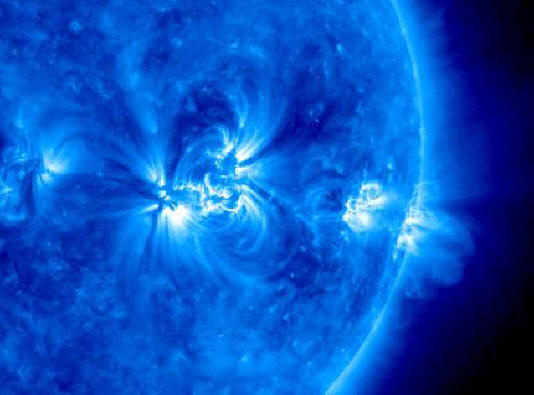|
|
Adhering to Fusion
Jan
09, 2009
Thermonuclear fusion reactions from
deep in the core are said to drive
the Sun. It has become so
commonplace an assumption that most
solar physicists say, "What else
could it be?""I
am aware that many critics consider
the stars are not hot enough. The
critics lay themselves open to an
obvious retort; we tell them to go
and find a hotter place."
--- Arthur Eddington
According to spectrographic
analysis, the Sun is composed
primarily of hydrogen gas (71%),
with 27% helium and the remainder
thought to be minute percentages of
oxygen, nitrogen, sulfur, carbon,
and six other elements. Although
every element on Earth can be seen
in a spectrogram of the Sun, those
12 make up 99.9% of its mass.
The Sun is 1,390,000 kilometers in
diameter, with a mass approximation
of 1.98 X 10^30 kilograms. The
temperature measured at its surface
is 5800 Kelvin and is estimated to
be as high as 15,600,000 Kelvin in
the core. As conventional models
suggest, the Sun must generate
outward radiation pressure or
gravity would compress it into a
relatively tiny, solid ball. The
theory states that an energy source
must exist inside the Sun, acting as
a counter force to gravitational
contraction.
It seemed to Sir Arthur Eddington in
his classic work,
The Internal Constitution of the
Stars, that only nuclear fusion
could produce radiative energy
sufficient to prevent the Sun from
collapsing "under its own weight"
and last for billions of years.
Since the processes by which
scientists describe those
fusion reactions were not
mathematically modeled until years
after Eddington's theory, it was
more a statement of faith at the
time than it was a result of
experimental research.
Hypothetically, how does the Sun
produce heat and light enough to
sustain life on our planet at a mean
distance of 149,476,000 kilometers?
When the Sun condensed out of the
nebular cloud that is supposed to
have been its nursery, the gases
were compressed by gravity until
they reached temperatures greater
than ten-million Kelvin. At that
temperature, hydrogen atoms are
disrupted into individual protons
and electrons, leaving the protons
free to collide with one another. It
is these initial proton collisions,
it is said, that are the first step
in a reaction called the
proton-proton (p-p) chain.
When protons collide at those high
temperatures, they are moving fast
enough to fuse into other particles:
deuterium, a positron and a
neutrino. Deuterium is a
proton-neutron combination, while a
positron is a positively charged
electron. Neutrinos are similar to
electrons, except they do not carry
an electric charge, and are almost
massless. Being neutral, they are
not affected by the electromagnetic
forces that affect electrons.
The second stage in the p-p reaction
is the formation of a helium-3
nucleus when the deuterium captures
another proton, while at the same
time emitting a gamma ray. A
helium-4 nucleus and two neutrinos
are the end results of the reaction,
although it can follow one of many
different reaction paths.
In reality, as Electric Universe
theorist
Wal Thornhill points out, stars
reside within plasma sheaths perhaps
as great as a light-day in extent.
They are the borders between the
electrical influence of the
stars and the currents flowing
through the galaxy.
As Wal wrote: "The Sunís plasma
sheath, or 'heliosphere' is about
100 times more distant than the
Earth is from the Sun. To give an
idea of the immensity of the
heliosphere, all of the stars in the
Milky Way could fit inside a sphere
encompassed by the orbit of Pluto.
The Sunís heliosphere could
accommodate the stars from 8 Milky
Ways! It is clear from the behavior
of its relatively cool photosphere
that the Sun is an anode, or
positively charged electrode, in a
galactic discharge. The red
chromosphere is the counterpart to
the glow above the anode surface in
a discharge tube. When the current
density is too high for the anode
surface to accommodate, a bright
secondary plasma forms within the
primary plasma. It is termed 'anode
tufting.' On the Sun, the tufts are
packed together tightly so that
their tops give the appearance of
'granulation.'Ē
The stars receive their power from
outside, not inside. Any nuclear
reactions are taking place on the
surface of the Sun and not in its
core. The solar wind is an electric
current connecting the Sun with its
family of planets and with its
galactic clan, so the 90-year-old
theory of fusion firing the solar
furnace needs to be reexamined.
By Stephen Smith
|
|
|
|
|
|
SPECIAL NOTE - **New Volumes Available:
We are pleased to announce a new
e-book series
THE UNIVERSE ELECTRIC. Available now, the first volume
of this series, titled Big Bang, summarizes the failure of modern cosmology
and offers a new electrical perspective on the cosmos. At
over 200 pages, and
designed for broadest public appeal, it combines spectacular
full-color graphics with lean and readily understandable
text.
**Then second and third volumes in the series are now available,
respectively titled Sun and Comet, they offer
the reader easy to understand explanations of how and why these bodies
exist within an Electric Universe.
High school and college students--and teachers in
numerous fields--will love these books. So will a large
audience of general readers.
Visitors to the Thunderbolts.info site have often
wondered whether they could fully appreciate the Electric
Universe without further formal education. The answer is
given by these exquisitely designed books. Readers from
virtually all backgrounds and education levels will find them
easy to comprehend, from start to finish.
For the Thunderbolts Project, this series is a milestone.
Please see for yourself by checking out the new
Thunderbolts Project website, our leading edge in
reaching new markets globally.
Please visit our
Forum
|
|
|
|
|
|
|
|







